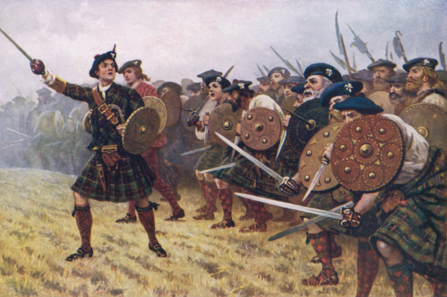Back

Collections
Scotland, Jacobite Rebellions 1715 and 1745
This expansive collection of records from The National Archives consists of lists of prisoners and those banished or pardoned during the Jacobite Rebellions. It also includes correspondence, commission records and briefs evidence.

- Date range
- 1701-1760
- Records
- 73,558
- Images
- 10,014
About this collection
This collection comprises of 193 pieces from 9 series from the National Archives covering the following:
- Administrative papers
- Assizes and special commissions
- Briefs of evidence
- Commissions
- Correspondence letters
- Evidence
- Journals and accounts
- List of the banished
- Lists of gentlemen, officers, rebels, uncaptured rebels and witnesses
- Papers relating to the Jacobite Rebellion
- Pardons
- Petitions, lists of prisoners and memorials
- Prisoner lists and records
- Proceedings against Scottish peers
- Transportation warrants
Predominately covering the years 1701-1719 and 1740-1767, there are almost 76,000 records in this collection from a significant period of Scotland’s history.
Jacobite Rebellion 1715
The 1715 Jacobite rebellion was the result of political division and turmoil. After the 1688 Revolution ended the reign of James II and the Catholic line of the Stuart dynasty, their supporters, the Jacobites refused to accept this revolution or the political settlement that followed. For three generations the exiled Stuarts, the Jacobites, and their allies plotted to restore the Stuarts to the throne.
The union of England and Scotland which took place in 1707 had been pushed through the Scottish Parliament with a view to securing George I’s secession.
Many Scots refused to accept the political union, for these Scots it was a betrayal of the nation. The equal political partnership promised with England proved to be hollow and reinforced their disillusionment with how the union worked.
With every crisis after the 1688 Revolution, the Jacobites viewed this as an opportunity to restore the Stuarts, such as the political turmoil in England in 1714-15. The Whigs and Tories were fighting for power in England and by 1714 both sides were secretly planning for armed conflict in case the other party gained political ground. When Queen Anne died on 1 August 1714 and Georg Ludwig, succeeded her, the Tories were outraged to find he strongly favoured the Whig party.
Those that were disillusioned were brought together by the Jacobite alternative King James ‘III and VIII’, the son of James II and VII. Tories who were fearful that George I’s support of the Whigs would mean the end of Anglican religious control in England rioted between the autumn of 1714 and the summer of 1715. In secret however, the Tory leader was negotiating with King James III for a new revolution that would return them to power.
In Scotland, encouraged by the disorder that was taking place in England, the Jacobites began secretly planning an uprising that would restore the Stuarts and lead to an independent Scotland. When George I and his ministers heard of this conspiracy they acted swiftly and arrested the Tory leaders in England but failed to catch the Jacobite leaders in Scotland.
On the 1 September 1715, after escaping from London to the Highlands, John Erskine, the Earl of Mar raised the Jacobite standard at Braemar and the rebellion began.
Jacobite Rebellion 1745
The Whigs had ruled Britain as a single party state since 1714, and they concluded the Jacobite threat was no more. However, with the ongoing sense of betrayal with the respect to the union among a sizeable minority in Scotland, the ongoing persecution of Catholics in Ireland and the rejection of the Tories in England the Jacobite movement remained active in these three kingdoms.
The Jacobite King James III’s son, Charles Edward Stuart (Bonnie Prince Charlie) had come to represent a new hope for many Jacobites.
In 1739, when Britain became involved in The War of Jenkins Ear, both France and Spain’s interest in supporting a Jacobite revolution was revived. In 1743-44 the French government secretly allied with the King James and the Tories, they planned to launch an invasion of England lead by Charles Edward Stuart. Due to hesitation by the Tories, bad weather and the action of the Royal Navy the invasion was prevented. As the months passed, the Jacobites stayed silent and Charles Edward Stuart remained in France preparing his own venture.
On the 5 July 1745, two ships, Du Teillay and Elisabeth set sail for Scotland with money, arms and troops. During the sailing, they were stopped by a patrolling Royal Navy warship and a battle ensued. The Elisabeth was badly damaged and had to return to France. However, Charles Edward Stuart undeterred sailed on to Scotland and landed on Eriskay on the 23 July 1745.
Charles Edward Stuart was able to gain support in Scotland by presenting the Jacobites with a dilemma, they could rise up and follow him and have the possibility of taking on the might of the British government army or they could abandon him to face potential capture and death. After an initial refusal by the Jacobites to act without major French support, Charles persuaded them to go it alone, as he had assurances the French would invade and the English Jacobites would rise if he raised Scotland and invaded England with the Jacobite army. Many Scots Jacobites were persuaded by this and decided to follow him and so began the rebellion of 1745.
- The National Archives, Kew, London, UK
Try the Social History Archive.